
Where the Wild Winds Blow, Part I
Mar 22, 2013
Editor's Note: This article is the first in a two-part series on the current state of the art in the study of wind engineering. It focuses on computational simulation of the interaction between wind and structures. The second will discuss small-scale and full-scale physical testing conducted at various facilities.
Every day, buildings are subjected to wind loads, whether we notice it or not. For many homes and commercial buildings in the U.S., winds exert the largest forces the structures will ever experience. The modern field of wind engineering evolved from early studies that tried to tackle the issues of wind loads on tall and long structures (the World Trade Center in New York being one of the most prominent projects). Wind engineers continue to dig deeper into the mechanics of how wind moves and imparts forces on the built environment.
The traditional wind engineering toolkit consists of wind tunnel testing of small-scale building models, full-scale structural testing (such as at Florida International University's Wall of Wind or the IBHS Research Center in South Carolina), actual field pressure measurements (Texas Tech's WERFL facility), and mechanical load and pressure testing (the Insurance Research Lab for Better Homes at the University of Western Ontario). Physical testing, however, comes with potentially high costs, large project time commitments, and limited facility availability. This has led some wind researchers to investigate the practical applicability of computer-based simulation techniques like computational fluid dynamics (CFD).
In recent years, rapid advancements in computational technology like multicore processing and large data storage, along with decreasing costs, have allowed computational modeling efforts to flourish alongside traditional physical simulation techniques. CFD allows mechanical, aerospace, and civil engineers to numerically simulate fluid flows using computational solutions. While aerospace engineers may use CFD to understand the dynamics of airflow around a wing, civil engineers can use CFD to study the flow of air around buildings without having to use costly wind tunnels. This article will explore the use of CFD in wind engineering and how it enhances AIR's understanding of building vulnerability.
The Benefits
The use of CFD in wind engineering has many advantages over traditional wind tunnel techniques, a primary one involving the issue of scaling. In wind tunnel simulations, models of buildings, as well as the wind characteristics themselves, have to be reduced appropriately to a scale that can fit in a small tunnel. This can be challenging and can significantly impact the results if not done correctly.
CFD, on the other hand, allows the researcher to model the wind and structures in full, real-world scale. Researchers can easily modify the testing model's geometry without having to construct new small-scale physical models. In addition, in a computational domain, measurements can be taken at any location the researcher chooses, whereas wind tunnel models require foreknowledge of critical measurement locations and the installation of pressure taps and tubing to capture data. And with computing power costs decreasing along with increasing speed, CFD simulation run times make it a practical alternative to wind tunnel simulations.
CFD has been instrumental in estimating the highly complex nature of wind flows and their effects on buildings in dense environments. The flows around streamlined bodies, such as airplane wings, are relatively easy to model because the flows remain attached due to their aerodynamic shape. However, the flow around a non-aerodynamic body, such as a building, is more difficult to model because of separation and reattachment phenomena that develop around sharp building corners, resulting in complex turbulence (Figure 1).
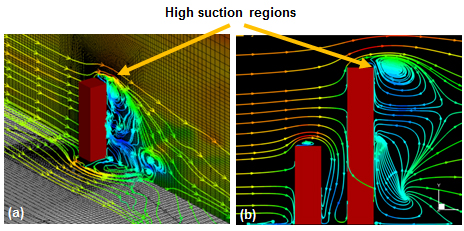
CFD can add value to catastrophe modeling by capturing relative changes in loading patterns due to different environmental and mitigation features and can also provide a tool for forensic analysis after major wind events. For example, Hurricane Ike generated a significant amount of cladding damage to high-rise structures in downtown Houston. Studies utilizing CFD demonstrated that the particular arrangement of buildings, coupled with the wind direction, created an environment in which wind vortices became trapped between two buildings (Figure 2). These vortices allowed for enhanced pressure loading on glass panels, which along with trapped debris, caused significant damage to a particular area of the building face (Butler and Kareem, 2012).
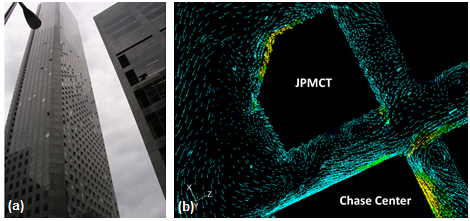
Evaluating the wind pressure distribution on the surface of low- and high-rise buildings through CFD can be extended to the assessment of a building's vulnerability. Damage surveys performed by AIR and others have shown that severe wind damage to roofs can initiate a structure's progressive collapse. By recreating different wind scenarios, CFD can be used to closely examine the distribution of wind pressures, providing insight into vulnerable building features.
For example, Figure 3a shows the distribution of the mean pressure coefficient on a hip roof residential house within a simulated hurricane wind environment (Dagnew and Bitsuamlak, 2012). One would expect to see damage to the roof surface where extremely high pressures or suction forces are found. It is also common for residential houses to have complex roof shapes (combinations of flat, gable, and hip roofs) for aesthetic reasons (see Figure 3b). In such homes, high suction forces can occur anywhere, and pinpointing the critical region is difficult without fully analyzing both the wind and the structure. For such circumstances, CFD is a useful tool to quickly investigate the relative roof pressure distribution and locate high wind hazard areas.
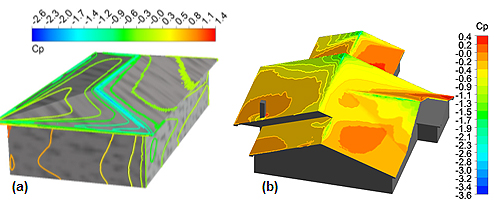
Capturing Complex Wind Fields
From the perspective of a single home, the large-scale nature of hurricane winds impacts a small structure much like a straight-line wind field. Severe convective storms, on the other hand, contain tornadoes and downbursts that are known for their violent turbulence and rotating wind fields in a small area. The small-scale rotation of tornadoes cannot be easily replicated in a wind tunnel setting. CFD simulations can help engineers understand both the evolution of the wind field and the loads on a structure during a tornado or downburst, since many of the full-scale characteristics can be replicated.
Figure 4a shows a simulated tornado using CFD and Figure 4b and c show an example of its simulated wind field interacting with a residential building. Due to the shape of the building and the rotating nature of the incoming wind, a series of localized vortices form on the windward side of the roof. The suction resulting from these localized vortices can potentially breach the roof system and lead to significant structural damage. Numerical analysis through CFD can help engineers identify critical loading conditions and understand the effects of various unique wind perils.
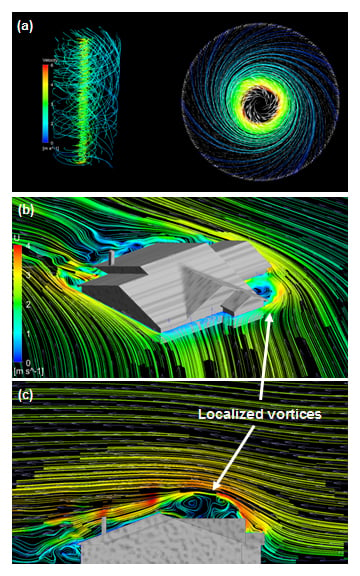
The dynamics of how wind and structures interact with each other is more complex in a metropolitan center where groups of building are located in close proximity to one another. In dense urban settings, the wind can become very turbulent and various types of interference can occur. With a well-constructed computational domain, CFD simulations can be useful in understanding how the flow is filtered by and through neighboring structures (Dagnew and Bitsuamlak, 2012).
Figure 5b shows a hurricane wind field near the ground surface in the Brickell section of Miami, Florida. The low-rise structures (small commercial buildings and railway bridges) increase the intensity of the wind, causing the high-rise buildings located downstream of the smaller buildings to experience high wind forces and possibly flying debris. In addition, channeling (which speeds up the wind) and sheltering (which creates a region of high suction) can manifest around the different structures (as shown in Figure 5c). In using small-scale structures in a traditional wind tunnel, it would be difficult to capture these phenomena visually (with smoke) or to measure them with instruments. However, modeling in full scale with CFD allows the researcher to control the level of measurement and observational detail needed.
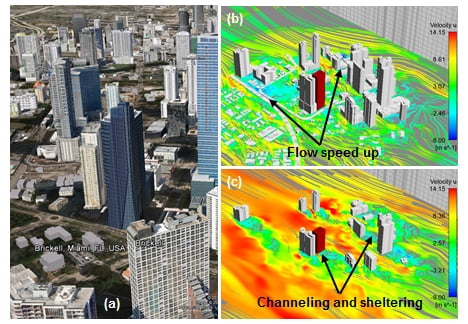
Closing Thoughts
Computational fluid dynamics is a versatile and economical tool wind engineers use to study the effects of wind on buildings. Sheltering, channeling, wake effects, and other complex interference mechanisms can be effectively modeled using CFD to better understand the nature of wind and structure interactions. Beyond wind load studies, CFD can be used in the development of mitigation solutions to improve the wind performance of buildings. Building- or site-specific studies can also be done using CFD analyses to identify possible areas of concern for structural damage or even the potential for content damage due to flying debris.
Still, even with its wide range of applications, CFD is not likely to fully replace traditional wind tunnel techniques in the near future. To solve the complex equations of fluid motion, certain assumptions and simplifications have to be made. Thus, a primary concern with CFD is the need for more validation with both full-scale and wind tunnel studies. CFD validation and improvement will come with time, as did validation of wind tunnels to full-scale results. In the interim, CFD can be utilized with confidence to study general interaction patterns and relative impacts.
CFD can tell one side of a story: how wind moves around structures and how wind loads manifest. The other side of the story requires further engineering analysis, mainly through the coupled use of CFD and structural finite element modeling to define detailed building resistance, and also through a detailed analysis of claims and damage data. Developing robust catastrophe models requires approaching vulnerability relationships from many different perspectives, and the second AIR Currents article in this two-part series will explain the role of physical testing.
A. Dagnew, G. Bitsuamlak, . 2012, "Numerical investigation of wind-induced pressure loads on low-rise residential buildings with complex roofs", The 3rd American Association for Wind Engineering Workshop, Hyannis, Massachusetts, August 12-14.
A. Dagnew, G. Bitsuamlak,. 2012, "Large eddy simulation for wind-induced response of tall buildings located in a city center", The 2012 Engineering Mechanics Institute & 11th ASCE Joint Specialty Conference on Probabilistic Mechanics and Structural Reliability (EMI/PMC 2012), Notre Dame, IN, June 17-20.
K. Butler, A. Kareem 2012, "Anatomy of Glass Damage in Urban Areas during Hurricanes", SEI & ATC Advances in Hurricane Engineering Conference: learning from the past, Miami, Florida, October 24-26

